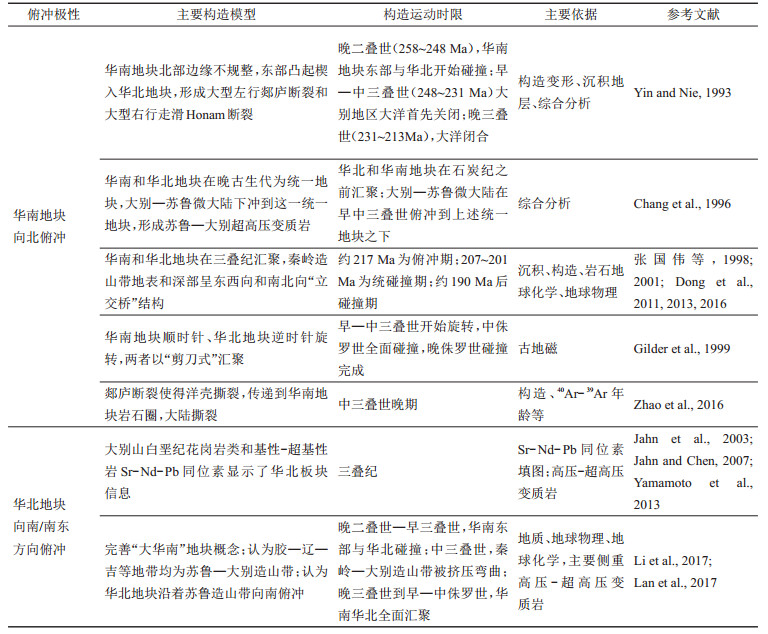2. 中国地质科学院地质研究所, 北京 100037;
3. 甘肃省有色金属地质勘查局白银矿产勘查院, 甘肃 白银 730900;
4. 中国石油集团东方地球物理勘探有限责任公司吐哈物探处, 新疆 哈密 839000
2. Institute of Geology, Chinese Academy of Geological Sciences, Beijing, 100037, China;
3. Institute of Mineral Exploration, Bureau of Gansu Non-ferrous Metals, Baiyin 730900, Gansu, China;
4. Tuha Division, Bureau of Geophysical Prospecting INC., China National Petroleum Corporation, Hami 839000, Xinjiang, China
地理上盆与山相互依存,地质上造山带与盆地相互耦合(李凤杰等,2008)。盆地与造山带在几何学和运动学上相互协调和改造,反映统一的地球动力学过程(张原庆等,2001;吴根耀等,2005),时间的同步性和动因的统一性是盆山耦合的关键(李凤杰等,2008)。盆山耦合主要表现在构造和沉积上(张进等,2004)。构造上,受同一地质事件影响,造山带影响弧前盆地、弧后盆地、周缘前陆盆地、弧后前陆盆地等的形成和演化;沉积上,盆地接受造山带剥蚀产物,记录具体造山过程,如Leiss通过对阿尔卑斯白垩纪同造山期沉积岩分析,限定了推覆体时代(Leiss, 1990)。
中央造山带为近东西向展布的造山带,黄汲清最早将其命名为昆仑—秦岭造山系或昆仑—秦岭褶皱系(黄汲清,1960),姜春发(1994)将其命名为中央造山带,它从水系、地理和气候等方面将中国大陆分隔为南北两部分,构成中国的脊梁(任纪舜,2004)。中央造山带北侧发育鄂尔多斯盆地,南侧发育四川盆地(图 1)。自印支期以来,中央造山带中部,即宝鸡—勉县—旺苍段(图 1中ABC剖面),发生多期、多极性强烈俯冲及造山事件,大量逆冲、走滑、褶皱及断层等多类地壳缩短构造发育(张国伟等,2001;Dong et al., 2011, 2016),前人做过大量研究(Yin and Nie, 1993; 张国伟等,2001;Jahn et al., 2003; Jahn and Chen, 2007; Yamamoto et al., 2013; Dong et al., 2013; Li et al., 2017; 陈宣华等,2019),提出了多种观点,不同认识中印支运动的启动时间不大相同。印支运动对中国现今大陆格架的建立,Pangea超大陆的最终拼贴,以及三叠纪全球主体构造格架的形成起到关键作用,其启动时间的限定具有重要意义。

|
图 1 研究区区域地质图 (地层代号及时代以中国地层表2014版为准) Fig. 1 Geological map of the study area (Geological legends after Chronostratigraphic Chart in China, 2014) |
古特提斯洋盆闭合,印支运动启动,华北克拉通与扬子(华南)地块碰撞拼贴(张国伟等,2001),形成了大别—苏鲁高压超高压变质带和东亚南部巨型印支造山系(许志琴等,2012)。前人对这一过程提出了不同地质模型(Yin and Nie, 1993; 张国伟等,2001;Jahn et al., 2003; Jahn and Chen, 2007; Yamamoto et al., 2013; Dong et al., 2014; Li et al., 2017)(图 2,表 1)。
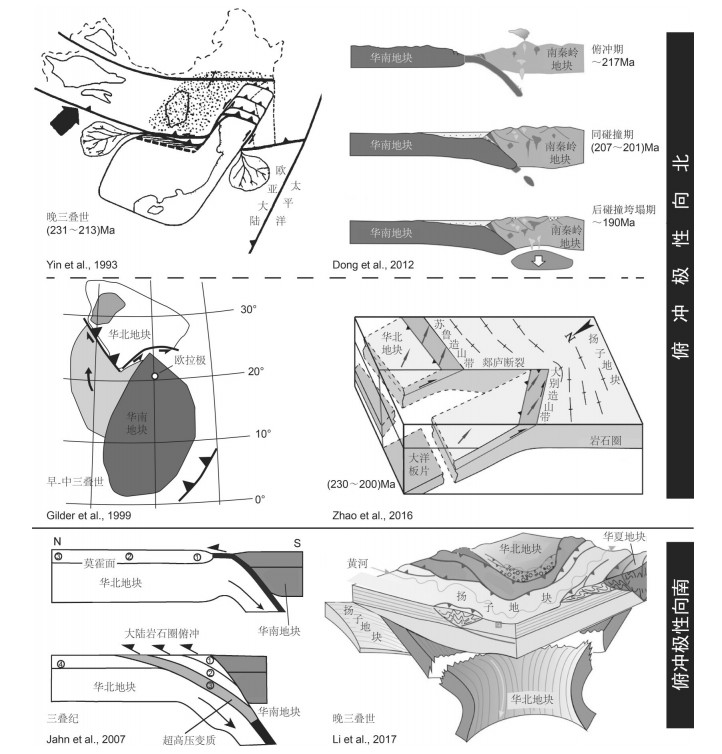
|
图 2 华北和华南地块汇聚模型及其印支运动时限 Fig. 2 Convergence models between North and South China blocks with respective Indosinian ages |
|
|
表 1 华北地块和华南地块汇聚代表性模型 Table 1 Classic convergence models between North and South China blocks |
总体而言,可将上述构造模式分为两类(图 2,表 1):(1)古特提斯洋壳向华北地块之下俯冲(Yin et al., 1993; 张国伟等2001;Dong et al., 2016),这一观点目前占主流地位;(2)华北地块向南俯冲,主要依据Sr-Nd-Pb同位素填图(Jahn et al., 2003; Jahn and Chen, 2007)和苏鲁—大别地区高压、超高压变质岩(Yamamoto et al., 2013; Li et al., 2017)。不同构造模式中,印支运动时限不一。此外,我们可以从下面几个方向讨论:
(1) 勉略缝合带时代。Dong et al.(2016)认为勉略蛇绿岩及相关的火山和岩浆岩同位素年龄为345~200 Ma(Li et al., 2004;Qin et al., 2008;Dong et al., 2011),含有石炭纪—三叠纪化石(Feng et al., 1996;边千韬等, 2001)。
(2) 中央造山带印支期岩浆岩时代。前人认为自252 Ma开始,中央造山带中部岩浆开始冷却(Wang et al., 2008, 2013),245~200 Ma发生大量同碰撞和后碰撞花岗岩,扬子地块在中晚三叠世与南秦岭地区发生碰撞(Dong et al., 2016)。
(3) 此外,Shi et al. (2012)认为在晚三叠世—早侏罗世(T3—J1),作为秦岭—大别造山带的前陆,大巴山表现为近N-S向至NNE-SSW向的挤压缩短,形成E-W向延伸的褶皱构造(Shi et al., 2012)和当阳盆地近N- S向的挤压缩短(Shi et al., 2013)。40Ar/39Ar年代学给出南秦岭(北大巴山)与华北和扬子地块碰撞有关的逆冲推覆作用时间为245~189 Ma(Li et al., 2013)。
可以看出,上述端元模式及不同学者的研究认识中,印支运动时限不一。因此笔者试图从盆山耦合的角度,对造山带及周缘盆地开展综合研究,探讨印支运动在鄂尔多斯盆地和四川盆地的启动时间。
3 盆山耦合构造与不整合发育特征 3.1 印支期沉积不整合沉积不整合在构造地质学上是造山幕建立或构造旋回划分的重要依据,代表重要的沉积间断,期间下盘发育褶皱、断裂、剥蚀,重新接受沉积。为此,笔者在鄂尔多斯盆地、四川盆地及中央造山带进行了沉积不整合观察。
鄂尔多斯盆地南部三叠系内部、三叠系和侏罗系之间发育大量不整合接触(图 3)。上三叠统延长组平行不整合于中三叠统纸坊组之上,侏罗系延安组与下伏延长组之间呈平行不整合接触。下白垩统与其下伏地层和上覆地层之间普遍为角度不整合,如永寿烂泥塘下白垩统与三叠系、平凉石灰沟下白垩统与二叠系、陇县窑厂沟下白垩统与三叠系、彬县百子沟下白垩统与侏罗系安定组等(图 3)。在中央造山带内部,受构造作用影响,大量沉积不整合发育(图 3),下三叠统西坡组和任家沟组主要为一套大理岩和浅变质碎屑岩,在青海隆务河一带与下伏石关组呈平行不整合接触,在中秦岭造山带与下伏石关组,在南秦岭与下伏迭山组、十里墩组为整合接触(图 3);在两当县南被下侏罗统龙家沟组不整合覆盖;在徽成盆地东龙家沟组与下伏下三叠统西坡组不整合接触(图 3)。综合而言,从鄂尔多斯盆地西缘(宁夏卫宁、固原、香山等地区)、西南缘六盘山、南缘麟游,秦岭造山带中部徽成盆地,四川盆地北缘大两会和旺苍等地区都可以看到三叠系与下伏地层/上覆地层之间的不整合接触(图 3),说明印支运动在研究区广泛发育。
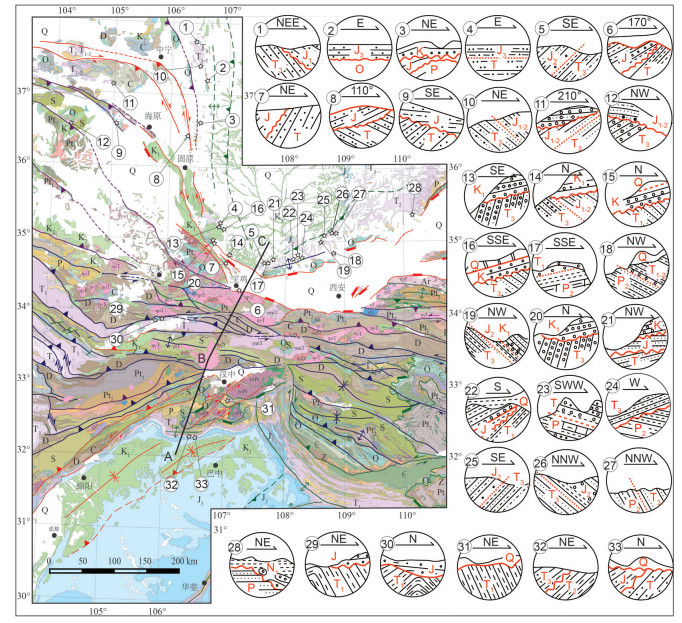
|
图 3 研究区区域角度不整合接触 (1~9据Guo et al., 2017;10~15据Chen et al., 2007;16~19据时建超,2010; 20~28据高飞,2009;29~33为本文资料) Fig. 3 Regional unconformity contacts in the study area (1~9 after Guo et al., 2017; 10~15 after Chen et al., 2007; 16~19 after Shi, 2010; 20~28 after Gao, 2009; 29~33 in this study) |
笔者沿中央造山带中部横跨造山带和两侧盆地开展了野外地质调查,在野外观测的基础上,综合区域地质和地球物理资料,建立了横跨研究区的构造地质剖面(剖面位置见图 1)(张义平,2018),揭示中央造山带与两侧盆地的构造格架。
剖面北起于鄂尔多斯盆地下白垩统志丹群,跨越中央造山带,向南到四川盆地旺苍县。鄂尔多斯盆地南缘西崛山为主体向北(断面倾向南)的挤压逆冲构造,在岐山地区可见出露地表的寒武系和奥陶系,中薄层灰岩形成枢纽走向近北东向的褶皱。向南为汾渭地堑(图 1),地堑形成时间晚于印支期,在一定程度上改造了早期构造。沿着剖面向南,商丹缝合带经历多期构造形变,出露大量糜棱岩与超基性岩(图 4)。南秦岭造山带主要为早古生代前陆区,沉积了志留系—下三叠统,包括现今徽成盆地。笔者在光头山岩体南侧火神庙乡详细观察了勉略韧性剪切变形,中泥盆统在强烈构造作用下变质变形,发生糜棱岩化,前人将勉略带归为印支期华北板块与华南板块拼接的缝合带(张国伟等,2001;Dong et al., 2016)。米仓山出露大量新元古代花岗岩,属于基底结晶岩系,其构造属性和归属复杂。有部分学者将米仓山和汉南杂岩分别研究,认为米仓山地区为卷入基底的大型背斜构造(杜思清等,1998;常远等,2010;田云涛等,2010)。
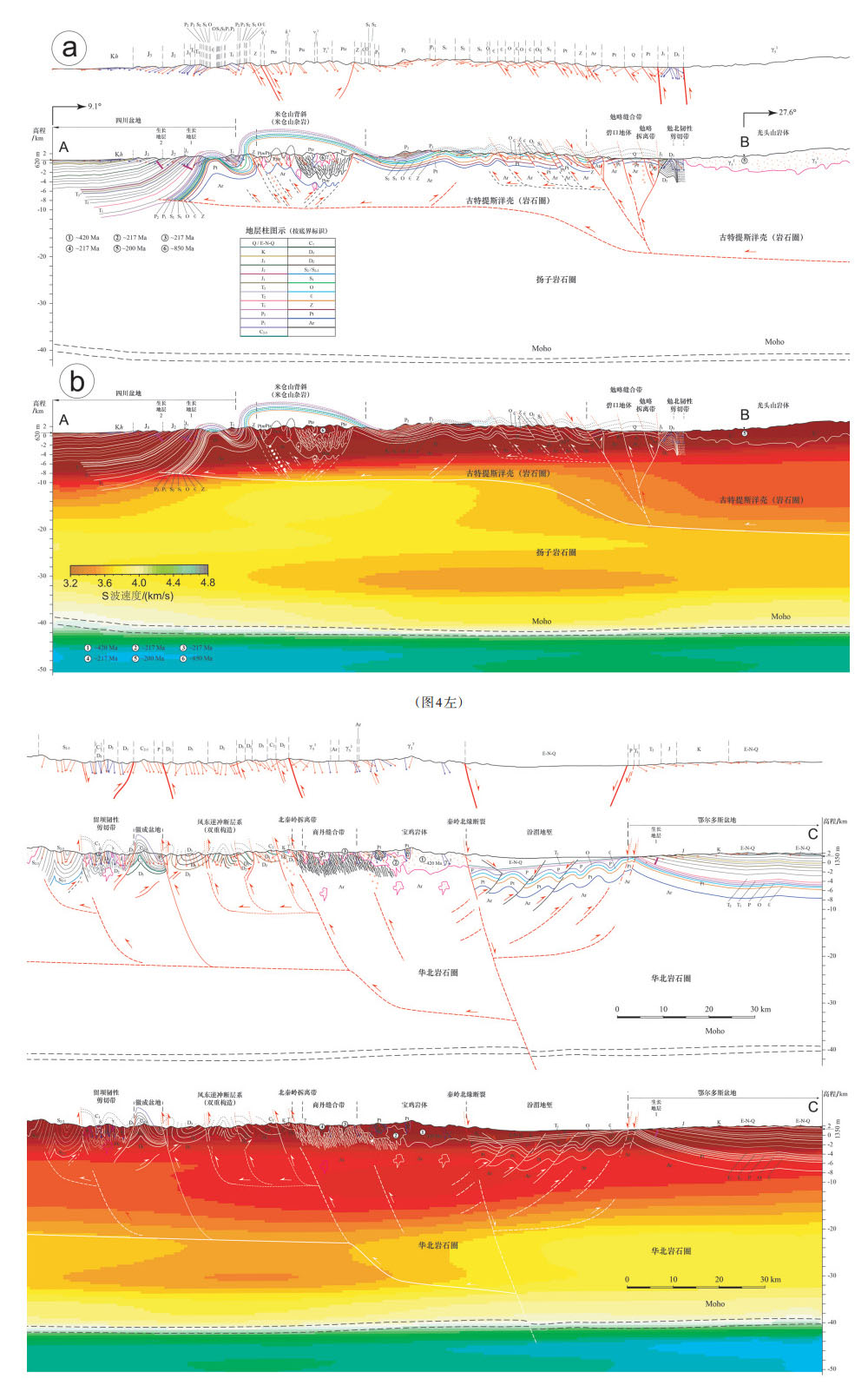
|
图 4 中央造山带构造剖面(剖面位置见图 1)(图 4右) Fig. 4 Structural profile across the Center China Orogen (location shown in Fig. 1) |
S波图像可显示构造剖面深部结构信息(图 4),结合浅部构造变形形迹,可以验证俯冲极性问题。图中最为显著的是中央造山带中部地区莫霍面深度约为40~43 km,两侧盆地莫霍面深度为40 km左右。就地壳结构而言,造山带和盆地有不同的显示,鄂尔多斯盆地沉积盖层厚度可达6 km左右,鄂尔多斯盆地基底深度可能达18 km,S波速约为3.7 km/s。北秦岭造山带下部可看到古老块体或岩体块状堆积,S波速达3.4 km/s,可能属于早古生代造山带产物。在秦岭造山带底部,出现一个深度可达30 km的圈状速度层,可能代表造山根的拆沉,也有可能对应前人认为的“立交桥”底部。勉略缝合带以南,S波速度3.7 km/s的底界面迅速抬升,形成一个弧状突变带,可能代表一个深层滑脱面。四川盆地底部速度界面为3.7 km/s,深度可达18 km。此外,在勉略缝合带至米仓山之间,出现一个与秦岭造山带相似的速度圈闭,S波速度为3.4 km/s左右(图 4)。
4 生长地层及其年代学约束生长地层也称同构造地层,通过生长地层底界时代推测相关构造起始时间(何登发等,2005;管树巍等,2007),进而对造山带与盆地耦合的启动时间进行限定。
4.1 测年样品分析及处理岩石样品碎样和锆石挑选工作由河北省区域地质矿产调查研究所实验室完成,在避免污染的条件下,将样品粉碎至60目以下,接着通过水洗和电磁选方法富集锆石,最后在双目显微镜下精选锆石颗粒,选出200粒以上碎屑锆石。锆石样品的制靶工作和阴极发光(CL)图像采集由北京锆年领航科技有限公司完成。将选出的碎屑锆石和标准锆石一起黏贴在环氧树脂表面制靶,通过透射光、反射光显微照相,观察其抛光面有无裂隙及包裹体等,然后进行阴极发光照相,观察锆石内部结构特征。
样品LA-ICP-MS锆石U-Pb定年测试分析在中国地质科学院矿产资源研究所完成。实验所用多接收器电感耦合等离子体质谱仪(Neptune)由Thermo Fisher公司制造,离子光学通路采用能量聚焦和质量聚焦的双聚焦合计,并采用动态变焦(ZOOM)使质量色散达到17%。该系统配备法拉第杯接收器9个,离子计数器接收器4个。激光器(UP193-FX准分子激光器)由美国ESI公司生产,激光波长193 nm,脉冲宽度5 ns,束斑直径2~150 μm可调,脉冲频率1~200 Hz连续可调。用He气将激光剥蚀物质送入Neptune,利用动态变焦扩大色散同时接收质量数相差很大的U-Pb同位素,进行锆石U-Pb同位素原位测定。外部锆石年龄标样为TEMORA,用NIST6玻璃标样作为外标计算锆石样品的Pb、U和Th含量。用ICPMSDataCal程序(Liu et al., 2008)和ISOPLOT软件(Version 4.1; Ludwig, 2003)进行数据处理并成图(李怀坤等,2009)。实验中借助锆石透射光、反射光、CL照片,避开包裹体,确定测点位置,用193 nm激光器对锆石进行剥蚀,激光频率为8~10 Hz,激光束斑直径为32 μm。
4.2 印支运动在鄂尔多斯盆地北缘的启动 4.2.1 鄂尔多斯盆地南缘生长地层鄂尔多斯盆地南缘上二叠统孙家沟组以角度不整合沉积于奥陶系三道沟组之上,二叠系底部出现含砾石粗砂岩(图 5),沉积环境发生变化。上二叠统孙家沟组地层产状从355°∠14°到5°∠16°(倾向与倾角,下同)不一,地层倾角保持在15°左右,与生长地层野外产状分部特征不符(图 5)。
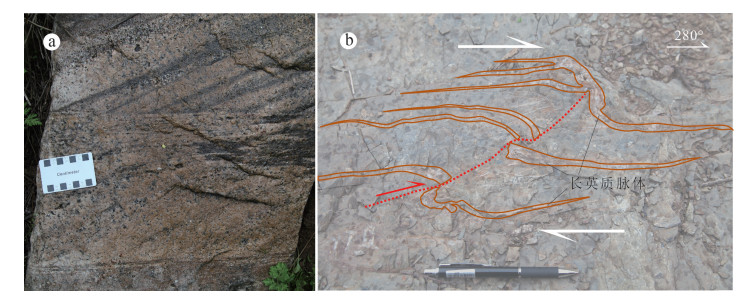
|
图 5 鄂尔多斯盆地南缘二叠系含砾石粗砂岩 Fig. 5 Permian gravel-bearing coarse sandstone in southern Ordos basin |
麟游县城地区中下三叠统刘家沟组和和尚沟组地层基本倾向北,倾角7°~5°。沿澄水河道向北地层产状基本一致,赵家台南侧(34°42′58.6″ N,107°47′53.7″ E)上三叠统延长组产状突变,呈3个倾角由大变小的序列。由最大倾角355°∠48°(34°43′ 1.1″ N,107°47′51.3″ E)变为312°∠5°(34°43′23.3″ N,107°47′41.9″ E),由此向北,上三叠统延长组地层倾角基本保持在5°左右(图 6b)。在不足1.5 km剖面上,地层倾角3次由陡变缓,未见明显断层、褶皱等构造,基本可以确定这种规律性变化源于同沉积作用,属于生长地层(图 6)。
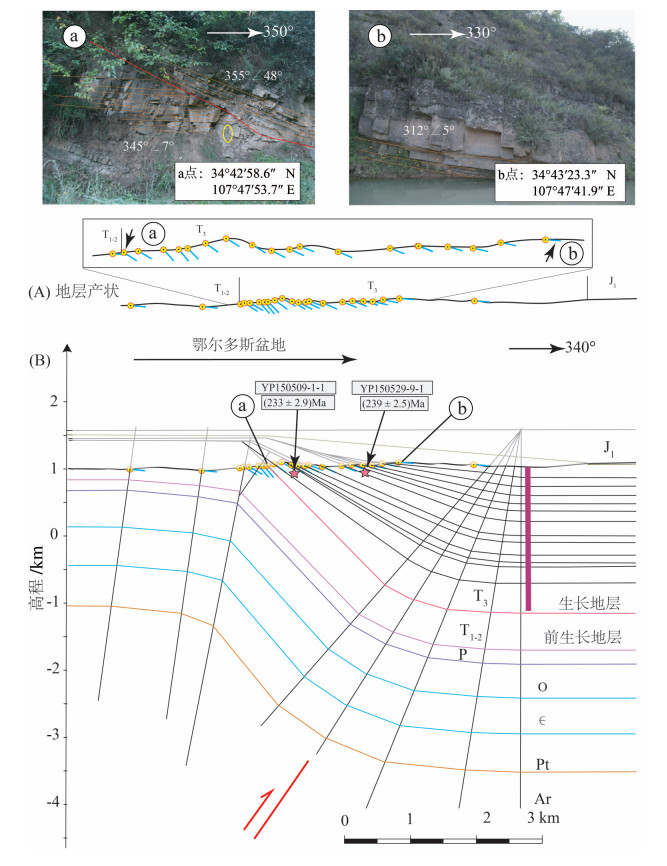
|
图 6 鄂尔多斯盆地南缘生长地层构造模式 Fig. 6 Growth strata on the southern margin of Ordos basin |
生长地层的识别不仅根据产状的规律性变化,还要符合生长地层的几何结构(Suppe et al., 1992)。因此,笔者结合区域地质对其构造格架进行了构建(图 6)。由图可以看出,上三叠统之前都可归为前生长地层。自上三叠统延长组开始,区内遭受的构造作用增强。发生明显退覆沉积,在褶皱顶部、前缘地层沉积一套同构造沉积地层(图 6)。随着前生长地层不断抬升,褶皱上部具有明显的超覆(高沉积速率)或减薄(低沉积速率)现象,发育生长不整合面(图 6)。生长地层结束后,上覆地层形成沉积披覆,构造变形停止之后,恢复了5°左右的地层倾角(图 6b)。
4.2.2 鄂尔多斯盆地南缘启动时间本文共采集2个岩石样品,均为延长组长石石英砂岩。样品YP150509-1-1(34°43.8247′N,107° 47.5765′E)采自延长组地层产状发生突变的第一个地质点,地层产状为355°∠48°;样品YP150529-9-1(34°43′52.65″ N,107°47′32.49″ E)采自地层倾角出现第二次由大变小处。笔者对样品进行了锆石UPb同位素测年,样品YP150509-1-1测得锆石120个,以谐和度90%遴选,大于1000 Ma时采用207Pb /206Pb表面年龄,小于1000 Ma时采用206Pb/238Pb表面年龄(Black et al, 2003),遴选后获得有效测点108个,基本满足年龄统计要求(Andersen,2005)。电子版表 1列出了有效测点数据,绘制成谐和线图(图 7)。108个有效点中有5个较为年轻的锆石,分别为测点P03((234±2.5)Ma)、P08((236±2.6)Ma)、P76((238 ± 2.9)Ma)、P84((233 ± 2.9)Ma)和点P93((233±3.4)Ma),这几个锆石Th/U比值在0.26~ 1.70,远大于0.1,锆石CL图像中环带清晰,可能为岩浆成因锆石。样品YP150529-9-1测得锆石110个,遴选后获得有效测点96个。96个有效点中有多个年轻锆石(图 7),其中最年轻锆石为测点P33((239±2.5)Ma),该锆石U含量36.6×10-6,Th/U比值为0.15,锆石Th/U比值大于0.1,CL图中环带清晰,可能为岩浆成因锆石。
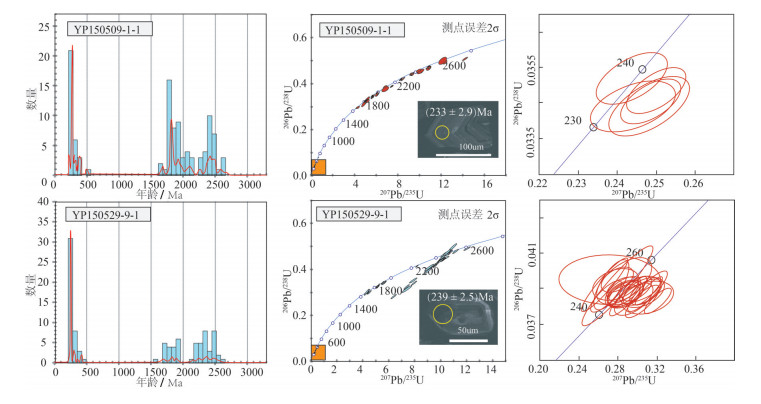
|
图 7 鄂尔多斯盆地南缘生长地层最年轻碎屑锆石U-Pb年龄 Fig. 7 The youngest zircon U-Pb ages of the growth strata on the southern margin of Ordos basin |
碎屑锆石来自沉积碎屑,时代应该早于沉积岩。如此而言,本文最年轻锆石可以限定生长地层沉积时代下限为(233±3.4)Ma,样品YP150529-9-1在层位上位于样品YP150509-1-1之上,但是最年轻锆石年龄却较样品YP150529-9-1最年轻锆石年龄大,可能受控于剥蚀和沉积镜像反序作用,也可能受实验条件控制。
王多云等(2014)在鄂尔多斯盆地西南缘环县和西峰地区通过钻井获得延长组7段凝灰岩样品L-1(36°56′22.03″N,107°26′44.19″E)和L-3(35°53′ 27.18″N,107°58′13.05″E),样品L-1年龄介于(227± 2.5)Ma~(245±3.8)Ma,最年轻3颗锆石206Pb/238Pb加权平均年龄为(230±2.7)Ma;Th含量为576×10- 6,Th/U比值为0.72。L-3样品的年龄介于(229±3.2)Ma~(246±3.7)Ma,206Pb/238Pb加权平均年龄为(239± 1.7)Ma,Th含量为294×10-6,Th/U比值为0.93。将本文获得最年轻碎屑锆石与L-1和L-3最年轻锆石作对比,可以看出同为岩浆锆石,且锆石的微量元素含量也基本匹配,两者可能具成因上的可对比性。换言之,本文最年轻碎屑锆石可能与凝灰岩同源,确定延长组生长地层的沉积年龄可能为(233± 3.4)Ma。生长地层沉积年龄可以代表构造事件时代,这样我们可以从沉积学角度限定印支运动在鄂尔多斯盆地南缘的启动时间为(233±3.4)Ma左右。
4.3 印支运动在四川盆地北缘的启动 4.3.1 四川盆地北缘生长地层四川盆地北缘中生代地层受巴河的冲蚀切割明显,出露齐全。本文剖面起点位于旺苍县东,终点位于盆地内马尚庙(图 8)。剖面地形最高点处为三叠系,中薄层含泥灰岩,夹持于大两会背斜与米仓山之间。该点具向斜区地形特征:向斜核部受地质应力作用,处于挤压状态,保存较好,地形较高;大两会背斜核部容易受风化剥蚀,地形明显较低(图 8)。
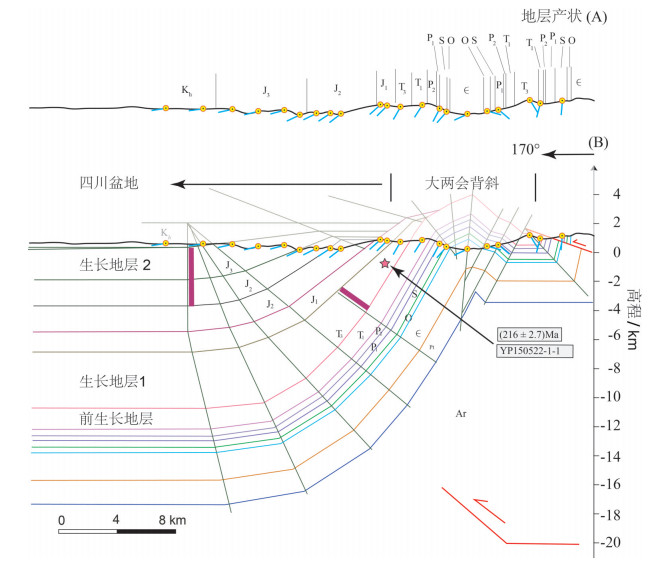
|
图 8 四川盆地北缘生长地层构造模式 Fig. 8 Growth strata on the northern margin of Sichuan basin |
大两会背斜南翼二叠系产状为176°∠44°,下三叠统飞仙关组产状为183°∠42°、179°∠40°等,飞仙关组出露厚度50 m左右,地层产状基本与下伏二叠纪地层一致,倾角40°左右。上三叠统须家河组岩性发生明显变化,须家河组底部可见厚层砾岩(图 9),向上逐渐过渡为灰白色厚层块状中细粒石英长石砂岩,粒度变细,产厚约20 m的煤层。须家河组地层产状发生了规律性变化,从底部168°∠33°到顶部181°∠31°,倾角较之前的40°左右明显变小(图 8)。下侏罗统白田坝组为黄灰色、黄绿色泥质粉砂岩,地层产状为179°∠30°,基本与上三叠统须家河组一致。中侏罗统千佛岩组地层倾角保持在30°左右,中侏罗统遂宁组产状为185°∠25°,上侏罗统蓬莱镇组地层产状变为169°∠10°,至蓬莱镇组顶部,地层倾角保持在7°左右,倾向南,下白垩统城墙岩组地层倾角基本保持在5°左右(图 8)。
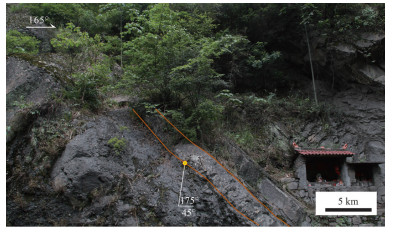
|
图 9 四川盆地北缘须家河组底部砾岩 Fig. 9 Conglomerate at the bottom of Xujiahe Formation on the northern margin of Sichuan basin |
结合区域地质,笔者对该区地层构造格架进行了构建(图 8)。图 8可以看出,上三叠统须家河组出现生长地层,前须家河组可归为前生长地层,随着断层相关褶皱的发育,须家河组发育由活动轴面与不活动轴面限定的生长三角(图 8)。中侏罗统遂宁组发育生长地层,前遂宁组可以看作这期生长地层的前生长地层。根据野外获得的地层产状基本可以肯定,该区生长地层生长几何形态不是典型的翼部旋转或翼部迁移模式,受两者共同作用(图 8)。生长地层第一次出现于上三叠统须家河组,这一时期形成的生长地层可能受控于印支运动;遂宁组时期,构造作用再次加强,形成燕山期生长地层,这一期的生长地层时间持续到侏罗纪结束;早白垩世基本保持构造寂静状态,地层产状未发生明显变化。
4.3.2 四川盆地北缘启动时间笔者观察并采集上三叠统须家河组样品YP150522-1-1(32°16′28.9″ N,106°32′07.6″ E),长石石英砂岩,地层产状183°∠30°,采样点北侧约100 m处可见须家河组底部砾岩(图 9),这套砾岩标志性明显,在野外有助于须家河组的识别。本次碎屑锆石测点100个,以谐和度90%遴选锆石U-Pb年龄数据,获得有效测点数据96个。电子版表 2列出了所有测点数据,并绘制成谐和线图(图 10),但频谱概率和年龄直方图(图 10)中只统计了有效数据。在96个有效点中有3个较为年轻的锆石,分别为测点P02((216±2.7)Ma)、P73((218±3.3)Ma)和P87((223±2.6)Ma),从测试结果(电子版表 2)来看,这3个测点U含量为135×10-6~617×10-6,Th/U比值为0.47~0.84,远大于0.1,锆石CL图中环带清晰,为岩浆锆石。
|
|
附表2 鄂尔多斯盆地南缘和四川盆地北缘生长地层最年轻碎屑锆石U-Pb同位素测试数据 Table 2 Zircon U-Pb isotope data of the youngest zircon U-Pb ages of the growth strata from the southern margin of Ordos basin and the northern margin of Sichuan basin |

|
图 10 四川盆地北缘生长地层最年轻碎屑锆石U-Pb年龄 Fig. 10 The youngest zircon U-Pb age of the growth strata on the northern margin of Sichuan basin |
将上三叠统须家河组获碎屑锆石与前人(Liu et al., 2017)上侏罗统遂宁组获得的碎屑锆石成分做对比,缺少遂宁组年轻锆石成分(如样品T-J3SN- 50.1的(165.3±2.8)Ma等)(Liu et al., 2017),这样从碎屑锆石年龄成分上而言,进一步确定了本文样品为上三叠统须家河组。本文获得的最年轻锆石年龄基本可以限定须家河组沉积年龄的底部界限为(216±2.7)Ma,故而笔者推测印支运动在四川盆地北缘的响应时间应该为(216±2.7)Ma左右。
5 中央造山带印支期盆山耦合中央造山带地区经历了多期构造演化事件,中新元古代北秦岭地体和华北板块拼贴,宽坪洋关闭,形成了宽坪缝合带,宽坪缝合带蛇绿岩年龄主要为ca.1.44~0.94 Ga(Diwu et al., 2010; Dong et al., 2013),俯冲碰撞花岗岩体年龄为ca.0.98~0.90 Ga(Wang et al., 1998; Pei et al., 2007; Wang et al., 2013)。早古生代商丹洋闭合,形成商丹缝合带,商丹缝合带蛇绿岩年龄为ca. 534~457 Ma(Pei et al., 2005; 2007; Chen et al., 2008; Dong et al., 2011),俯冲碰撞花岗岩为ca. 514~402 Ma(Xue et al., 1996;Chen et al., 2008;Wang et al., 2009;Dong et al., 2011)。商丹洋最早可能在早泥盆世关闭,形成早古生代北秦岭造山带(Dong et al., 2011)。Dong et al.(2013)通过碎屑锆石的研究认为商丹洋闭合之后,北秦岭造山带和南秦岭碰撞拼贴,北秦岭强烈造山,南秦岭转化为前陆构造环境。
考虑到现今勉略带沿线一系列基性-超基性岩石紧邻中央造山带南缘分布,且一系列三叠纪岩浆活动大部分发育在勉略带以北等基础地质现象,结合深部构造剖面符合古特提斯洋壳向北俯冲特征这一证据(图 4),本文暂以古特提斯洋壳向北俯冲作为基础地质模型讨论(表 1,图 2)。随着古特提斯洋壳向北俯冲(Zhang et al., 2016, 2017),北秦岭造山带不断受到挤压,持续隆升造山。随着不断向北挤压汇聚,南秦岭地区受到挤压,海水退去,到早三叠世时仅在徽成盆地地区形成下三叠统西坡组和任家沟组沉积,其碎屑锆石中含有的北秦岭早古生代锆石年龄说明北秦岭地区在此时已经发生了较大规模的抬升剥露(图 11)。

|
图 11 印支期大地构造环境 Fig. 11 Tectonic setting of the study area in the Indosinian period |
自晚三叠世开始,古特提斯洋在三叠纪开始关闭,大洋板块不断向南秦岭造山带之下俯冲(张义平等, 2015a, 2015b),依次发生点式和面式碰撞。构造上,印支期中央造山带中部为南北向挤压应力(图 11,图 12),古特提斯洋的消亡伴随南秦岭造山带挤压褶皱,北秦岭造山带早期构造活化,如徽成盆地北缘丹阳—凤县断裂的左行走滑导致糜署岭岩体和太白山岩体呈σ形态产出(图 12)等。在南秦岭地区,凤县东侧逆冲双重构造显示出自北东向南西的逆冲褶皱和断层(图 12);徽成盆地南侧至勉略缝合带之间,形成了以志留系为核部,泥盆系和石炭系为翼部的背斜构造(图 12)。
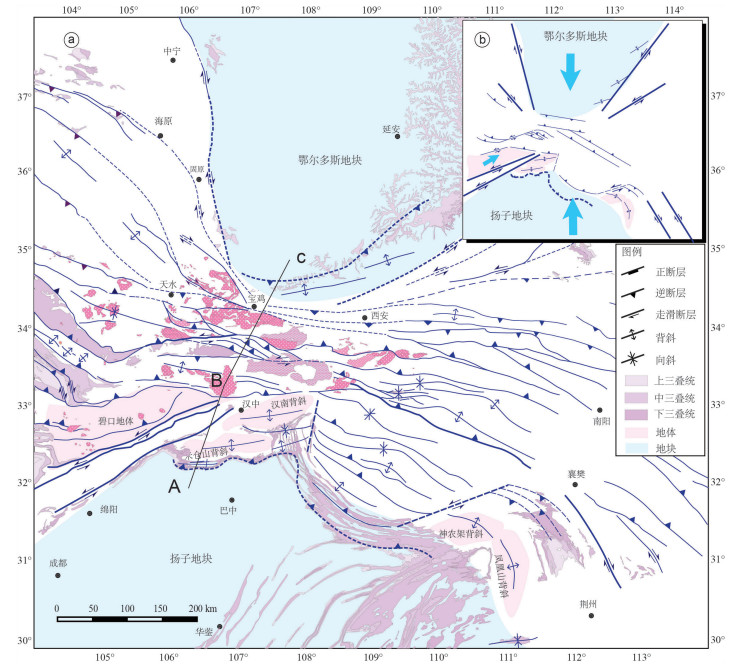
|
图 12 印支期盆山构造体系及三叠纪盆地分布 Fig. 12 Structure system and Triassic basins in the Indosinian period |
印支期盆山耦合作用在鄂尔多斯盆地表现强烈,为造山带后缘前陆地区(图 11,图 12),伴随一系列沉积学证据,如上三叠统延长组生长地层(ca.233 Ma)(图 6)和延长组内火山凝灰岩(ca. 233 Ma,王多云等,2014)。鄂尔多斯南缘广泛发育角度不整合(图 3),三叠系层内、三叠系和侏罗系之间,沉积地层表现为平行不整合或角度不整合接触。
四川盆地北缘的汉南—米仓山地区在晚三叠世虽然受到挤压褶皱,但还未隆起剥蚀(张义平,2018),勉略缝合带以南地区处于勉略缝合带前陆地区(董云鹏等,1995;刘少峰等,2008;Liu et al., 2015)。晚三叠世发育须家河组底部砾岩沉积层(图 9),须家河组内出现生长地层(ca. 216 Ma)(图 8),且在多地不整合于中三叠统及更老地层之上(图 3),Liu et al.(2015)也报道了南大巴山地区镇巴断裂多处三叠统或下侏罗统地层角度不整合于下伏地层之上(Liu et al., 2015)。
6 结论本文明确了印支运动在鄂尔多斯盆地和四川盆地的启动时间。鄂尔多斯盆地南缘上三叠统延长组生长地层最年轻碎屑锆石年龄为(233±3.4)Ma,与同层位凝灰岩时代(ca. 230Ma)一致,据此限定印支构造事件在鄂尔多斯盆地启动时间为233 Ma左右。四川盆地北缘上三叠统须家河组生长地层最年轻锆石年龄时代为(216±2.7)Ma左右,与中侏罗统遂宁组碎屑锆石年龄和构造位置作对比,据此限定印支构造事件在四川盆地的启动时间约为216 Ma。此基础上,本文讨论了印支期中央造山带盆山耦合关系。
致谢: 本文在完成的过程中,参与过野外工作的有李江瑜、史建杰、张艳国、罗英杰等;室内工作得到王亚莹和苗慧心等人的帮助,在此一并致谢。
Andersen T. 2005. Detrital zircons as tracers of sedimentary provenance:Limiting conditions from statistics and numerical simulation[J]. Chemical Geology, 216(3/4): 249-270. |
Bian Qiantao, Luo Xiaoquan, Li Dihui, Zhao Dasheng, Chen Haihong, Xu Guizhong, Chang Chengfa, Gao Yanlin. 2001. Geochemistry and formation environment of the Buqingshan ophiolite comples, Qinghai Province, China[J]. Acta Geologica Sinica, 75(1): 45-55 (in Chinese with English abstract). |
Black L P, Kamo S L, Allen C M, Aleinikoff J N, Davis D W, Korsch R J. 2003. TEMORA 1:A new zircon standard for Phanerozoic UPb geochronology[J]. Chemical Geology, 200(1/2): 155-170. |
Chang E Z. 1996. Collision orogen between north and south china and its eastern extension in the korean peninsula[J]. Journal of Asian Earth Sciences, 13(3/5): 267-277. |
Chang Yuan, Xu Changhai, Peter W.Reiners, Zhou Zuyi. 2010. The exhumation evolutioin of the Micangshan Hanan uplift since Cretaceous:Evidence from apatite (U-Th)/He dating[J]. Chinese Journal of Geophysics, 53(4): 912-919 (in Chinese with English abstract). |
Chen Gang, Wang Zhiwei, Bai Guojuan, Sun Jianbo, Zhang Huiruo, Li Xiangdong. 2007. Meso-Cenozoic peak-age events and their tectono-sedimentary response in the Ordos basin[J]. Geology in China, 34(3): 375-383. |
Chen J L, Xu X Y, Wang Z Q, Yan Q R, Wang H L, Zeng Z X, Li P. 2008. Geological featuresand SHRIMP U-Pb zircon age of the Yanwan-Yinggezui ophiolitic melange in the Taibai area, West Qinling, China[J]. Geological Bulletin of China, 27: 500-509. |
Chen Xuanhua, Li Jiangyu, Dong Shuwen, Shi Wei, Bai Yanfei, Zhang Yiping, Ding Weicui. 2019. Tectonic Deformation of Jurassic Ningwu-Jingle Basin and its implication for the beginning of Yanshanian Orogeny in Central North China Craton[J]. Geotectonica et Metallogenia, 43(3): 389-408 (in Chinese with English abstract). |
Diwu C R, Sun Y, Liu L, Zhang C L, Wang H L. 2010. The disintegration of Kuanping Group in North Qinling orogenic belts and Neoproterozoic N-MORB[J]. Acta Petrologica Sinica, 26: 2025-2038. |
Dong Yunpeng, Zhou Dingwu, Liu Liang. 1995. Deformation and evolution of Songshugou ophiote in Eastern Qinling[J]. Northwest Geoscience, 3: 37-47 (in Chinese with English abstract). |
Dong Y P, Zhang G W, Neubarer F, Liu X, Genser, J, Hauzenberger C. 2011. Tectonic evolution of the Qinling Orogen, China:Review and synthesis[J]. Journal of Asian Earth Sciences, 41: 213-237. DOI:10.1016/j.jseaes.2011.03.002 |
Dong Y P, L iu, X M, Neubauer F, Zhang G W, Tao N, Zhang, Y G, Zhang X N, Li W. 2013. Timing of Paleozoic amalgamation between the North China and South China Blocks:Evidence from detrital zircon U-Pb ages[J]. Tectonophysics, 586: 173-191. DOI:10.1016/j.tecto.2012.11.018 |
Dong Y P, Santosh M. 2016. Tectonic architecture and multiple orogeny of the Qinling Orogenic Belt, Central China[J]. Gondwana Research, 29(1): 1-40. DOI:10.1016/j.gr.2015.06.009 |
Du Siqing, Wei Xiangui. 1998. The NE-SW Nappe tectonic of superposed E-W structure in Hannan-Micangshan Area[J]. Journal of Chengdu University of Technology, 3: 367-374 (in Chinese with English abstract). |
Feng Q L, Du Y S, Yin H F, Sheng J H, Xu J F. 1996. Carboniferous radiolaria fauna firstly discovered in Mian-Lue ophiolitic melange belt of south Qinling Mountains[J]. Science in China (Series D), 39: 87-91. |
Gao Fei. 2009. Meso-Cenozoic Structural Characteristics and Its Evolution and Reformation in Weibei Area[D]. Xi'an: Northwest Universiy(in Chinese with English abstract).
|
Gilder S A, Leloup P H, Courtillot V. 1999. Tectonic evolution of tancheng-lujiang (tan-lu) fault via middle triassic to early cenozoic paleomagnetic data[J]. Journal of Geophysical Research Atmospheres, 104(15): 365-375. |
Guan Shuwei, Li Benliang, He Dengfa, Wang Xin, Supp J. 2007. Geometrical Methods of complicated structural analysis and their application[J]. Chinese Journal of Geology, 42(4): 722-739 (in Chinese with English abstract). |
Guo P, Liu C, Wang J, Deng Y, Mao G, Wang W. 2017. Detritalzircon geochronology of the Jurassic coal-bearing strata in the western Ordos Basin, North China:Evidences for multi-cycle sedimentation[J]. Geoscience Frontiers, 9(6): 136-154. |
Huang Jiqing. 1960. The Main Characteristics of the Structure of China:Preliminary Conclusions[J]. Scientia Sinica, 9(4): 492-544. |
He Dengfa, Jia Chengzao, Li Desheng, Zhang Chaojun, Meng Qinren, Shi Xin. 2005. Formation and evolution of polycyclic superimposed Tarim Basin[J]. Oil & Gas Geology, 26(1): 64-77 (in Chinese with English abstract). |
Jahn B M, Fan Q, Yang J J, Henin O. 2003. Petrogenesis of the maowu pyroxenite-eclogite body from the uhp metamorphic terrane of Dabieshan:Chemical and isotopic constraints[J]. Lithos, 70(3): 243-267. |
Jahn B M, Chen B. 2007. Dabieshan uhp metamorphic terrane:sr-ndpb isotopic constraint to pre-metamorphic subduction polarity[J]. International Geology Review, 49(1): 14-29. DOI:10.2747/0020-6814.49.1.14 |
Jiang Chunfa. 1994. Main geologic-tectonic characteristics of the Central China Orogen[C]//Corpus of Institute of Geology, Chinese Academy of Geological Sciences(in Chinese).
|
Lan H Y, Li S Z, Li X Y, Wang P C, Somerville I D, Guo L L, Wang Q, Guo R H, Zhang J, Tao J L. 2017. Early mesozoic intracontinental deformation in the eastern North China block:Implication for an indentation model of North China to south China blocks[J]. Geological Journal, 52(S1): 8-21. |
Li S G, Hou Z H, Yang Y C, Sun W D, Zhang G W, Li Q L. 2004. Timing and geochemistry characters of the Sanchazi magmatic arc in Mianlue tectonic zone, South Qinling[J]. Science in China(Series D), 47: 317-328. DOI:10.1360/02YD0490 |
Li Fengjie, Zheng Rongcai, Jiang Bin. 2008. Main basin and mountain coupling systems and their characteristics in China continent[J]. Lithologic Reservoris, 20(4): 26-32 (in Chinese with English abstract). |
Li Huaikun, Geng Jianzhen, Hao Shuang, Zhang Yongqing, Li Huimin. 2009. Research on the zircon U-Pb isotopic age by Iaser Ablation Multi-Receiver Plasma Mass Spectrometry (LA-MCICPMS)[J]. Acta Mineralogica Sinica, 29(1): 600-601 (in Chinese). |
Li J H, Zhang Y, Dong S, Shi W. 2013. Structural and geochronological constraints on the Mesozoic tectonic evolution of the North Dabashan zone, South Qinling, central China[J]. Journal of Asian Earth Sciences, 64(64): 99-114. |
Li S Z, Jahn B M, Zhao S, Dai L, Li X, Suo Y. 2017. Triassic southeastward subduction of north China block to south China block:insights from new geological, geophysical and geochemical data[J]. Earth-Science Reviews, 166: 270-285. DOI:10.1016/j.earscirev.2017.01.009 |
Liu S F, Li W, Wang K, Qian T, Jiang C. 2015. Late Mesozoic development of the southern Qinling-Dabieshan foreland foldthrust belt, Central China, and its role in continent-continent collision[J]. Tectonophysics, 644: 220-234. |
Liu Shaofeng, Zhang Guowei. 2008. Evolution and Geodynamics of basin/mountain systems in East Qinling-Dabieshan and its adjacent regions, China[J]. Geological Bulletin of China, 27(12): 1943-1960 (in Chinese with English abstract). |
Liu G, Dong S W, Chen X H, Cui J J. 2017. Detrital zircon U-Pb dating of Suining Formation sandstone from the Daba Mountains, northeastern Sichuan and its stratigraphic implications[J]. Palaeoworld, 26(2): 380-395. DOI:10.1016/j.palwor.2017.03.002 |
Ludwig K R. 2003. User's Manual for Isoplot 3.00. A Geochronological Toolkit for Microsoft Excel[M]. Berkeley Geochronology Center, Special Publication No. 4a, Berkeley, CA.
|
Leiss Otto. 1990. New interpretations of geodynamics and orogeny as a result of synorogenic Cretaceous deposits within the Northern Calcareous Alps[J]. Geologische Rundschau, 79(1): 47-84. DOI:10.1007/BF01830447 |
Pei X Z, Ding S P, Li Z C, Liu Z Q, Li GY, Li R B, Wang F, Li F J. 2007. LA-ICP-MS zircon U-Pb dating of the Gabbro from the Guanzizhen Ophiolite in the North Margin of the Western Qinling and its geologic siginificance[J]. Acta Geologica Sinica, 81: 1550-1561. |
Qin J F, Lai S C, Li Y J. 2008. Slab breakoff model for the Triassic post-collisional adakitic granitoids in the Qinling Orogen, Central China:Zircon U-Pb ages, geochemistry, and Sr-Nd-Pb isotopic constraints[J]. International Geology Review, 50: 1080-1104. DOI:10.2747/0020-6814.50.12.1080 |
Qiu Xinwei. 2008. Characteristics and Sedimentary Environment of Tuff in Yanchang Formation of Ordos Basin[D]. Xi'an: Northwest University(in Chinese with English abstract).
|
Ren Jishun. 2004. Some problems on the Kunlun-Qinling orogenic system[J]. Northwest Geolgoy, 37(1): 1-5 (in Chinese with English abstract). |
Shi Jianchao. 2010. The Mesozoic-Cenozoic Structural Characteristics and Its Evolution in Southern Ordos Region[D]. Xi'an: Northwest University(in Chinese with English abstract).
|
Shi W, Zhang Y Q, Dong S W, Hu J M, Wiesinger M, Ratschbacher L, Jonckheere R, Li J H, Tian M, Chen H, Wu G L, Qu H J, Ma L C, Li H L. 2012. Intra-continental Dabashan orocline southwestern Qinling central China[J]. Journal of Asian Earth Sciences, 46: 20-38. DOI:10.1016/j.jseaes.2011.10.005 |
Shi W, Dong S W, Ratschbacher L, Tian M, Li J H, Wu G L. 2013. Meso-Cenozoic tectonic evolution of the Dangyang Basin northcentral Yangtze craton central China[J]. International Geology Review, 55(3): 382-396. DOI:10.1080/00206814.2012.715732 |
Suppe J, Chou G T, Hook S C. 1992. Rates of folding and faulting determined from growth strata[C]//McClay K R(ed.). Thrust Tectonics. Chapman & Hall, New York. 105-121.
|
Tian Yuntao, Zhu Chuanqing, Xu Ming, Rao Song, Barry P. Kohn, Hu Shengbiao. 2010. Exhumation history of the Micangshan Hannan Dome since Cretaceous and its tectonic significance:evidence from Apatite fission Track analysis[J]. Chinese Journal of Geophysics, 53(4): 920-930 (in Chinese with English abstract). |
Wang Duoyun, Xin Bushe, Yang Hua, Fu Jinhua, Yao Jingli, Zhang Yu. 2004. Zircon SHRIMP U-Pb age and geological implications of tuff at the bottom of Chang-7 Member of Yanchang Formation in the Ordos Basin[J]. Science China:Earth Science, 10: 2160-2171 (in Chinese). |
Wang X, Wang T, Haapala I. 2008. P-T conditions of crystallization and origin of plagioclase-mantled alkali feldspar megacrysts in the Mesozoic granitoids in the Qinling orogen (China)[J]. Lithos, 103: 289-308. DOI:10.1016/j.lithos.2007.09.020 |
Wang X, Wang T, Zhang C. 2013. Neoproterozoic, Paleozoic, and Mesozoic granitoid magmatism in the Qinling Orogen, China:Constraints on orogenic process[J]. Journal of Asian Earth Sciences, 72(4): 129-151. |
Wang T, Wang X X, Tian W, Zhang C L, Li W P, Li S. 2009. North Qinling Paleozoic granite associations and their variation in space and time:Implications for orogenic processes in the orogens of central China[J]. Science in China (Series D), 52: 1359-1384. DOI:10.1007/s11430-009-0129-5 |
Xue F, Kröner A, Reischmann T, Lerch M F. 1996. Palaeozoic preand post-collision calc-alkaline magmatism in the Qinling orogenic belt, central China, as documented by zircon ages on granitoid rocks[J]. Journal of the Geological Society, 153: 409-417. DOI:10.1144/gsjgs.153.3.0409 |
Xu Zhiqin, Yang Jingsui, Li Huaqi, Wang Ruirui, Cai Zhihui. 2012. Indosinian collision-orogenic system of Chinese continent and its orogenic mechanism[J]. Acta Petrologica Sinica, 28(6): 1697-1709 (in Chinese with English abstract). |
Yamamoto H, Terabayashi M, Okura H, Matsui T, Kaneko Y, Ishikawa M. 2013. Northward extrusion of the ultrahigh-pressure units in the southern dabie metamorphic belt, east-central china[J]. Island Arc, 22(1): 51-62. DOI:10.1111/iar.12004 |
Yin A, Nie S Y. 1993. An indentation model for the north and south china collision and the development of the tan-lu and honam fault systems, eastern asia[J]. Tectonics, 12(4): 801-813. DOI:10.1029/93TC00313 |
Zhao T, Zhu G, Lin S, Wang H. 2016. Indentation-induced tearing of a subducting continent:evidence from the tan-lu fault zone, east china[J]. Earth-Science Reviews, 152: 14-36. DOI:10.1016/j.earscirev.2015.11.003 |
Zhang Yuanqing, Qian Xianglin. 2001. Concepts and Mechanism of Basin-Range Coupling[J]. Geolgoy in China, 28(3): 47 (in Chinese). |
Zhang Guowei, Zhang Benren, Yuan Xuecheng, Xiao Qinghui. 2001. Qingling Orogenic Belt and Continental Dynamics[M]. Beijing: Science Press, 1-855 (in Chinese).
|
Zhang Jin, Ma Zongjin, Ren Wenjun. 2004. Thingking on the present research of Basin-Mountain coupling[J]. Petroleum Geology & Experiment, 26(2): 169-175 (in Chinese with English abstract). |
Zhang Yiping, Xiao Wenxia, Zhang Jin, Chen Xuanhua, Zhang Beihang, Zhao Heng, Wang Yannan, Li Jiangyu, Shi Jianjie. 2015. A discussion on the provenance and age of Xiangshan Group in Eastern Hexi Corridor[J]. Geology in China, 42(6): 1774-1792 (in Chinese with English abstract). |
Zhang Yiping, Zhang Jin, Chen Bihe, Wang Zongxiu, Zhang Beihang, Zhao Heng. 2015b. Geochronology of Baimashan granitic composite batholith of Hunan Province and its constraints on the timing of regional deformation[J]. Acta Geologica Sinica, 89(1): 1-17 (in Chinese with English abstract). DOI:10.1111/1755-6724.12390 |
Zhang Y P, Chen X H, Zhang J. 2016. Geochronology and tectonic implications of diabase intruded into Xiangshan Group in the Southeastern Alxa Block, NW China[J]. Acta Geologica Sinica(English Edition), 90(s1): 88-91. DOI:10.1111/1755-6724.12904 |
Zhang Y P, Zhang J, Chen X H, Wang Y N, Zhao H, Nie F J, Zhang B H. 2017. Late Palaeozoic tectonic setting of the southern Alxa Block, NW China:Constrained by age and composition of diabase[J]. International Geology Review, 59(8): 1028-1046. DOI:10.1080/00206814.2016.1253036 |
Zhang Yiping, 2018, Mesozoic Range-basin Coupling and Tectonic Evolution of the Mid-segment of the Central China Orogen[D]. Chinese Academy of Geological Sciences(in Chinese with English abstract).
|
边千韬, 罗小全, 李涤徽, 赵大升, 陈海泓, 徐贵忠, 常承法, 高延林. 2001. 青海省阿尼玛卿带布青山蛇绿混杂岩的地球化学性质及形成环境[J]. 地质学报, 75(1): 45-55. DOI:10.3321/j.issn:0001-5717.2001.01.005 |
常远, 许长海, Peter W.Reiners, 周祖翼. 2010. 米仓山-汉南隆起白垩纪以来的剥露作用:磷灰石(U-Th)/He年龄记录[J]. 地球物理学报, 53(4): 912-919. DOI:10.3969/j.issn.0001-5733.2010.04.016 |
陈刚, 王志维, 白国绢, 孙建博, 章辉若, 李向东. 2007. 鄂尔多斯盆地中新生代峰值年龄事件及其沉积-构造响应[J]. 中国地质, 34(3): 375-383. DOI:10.3969/j.issn.1000-3657.2007.03.002 |
陈宣华, 李江瑜, 董树文, 施炜, 白彦飞, 张义平, 丁伟翠. 2019. 华北克拉通中部宁武-静乐盆地侏罗纪构造变形与燕山期造山事件的启动[J]. 大地构造与成矿学, 43(3): 389-408. |
杜思清, 魏显贵. 1998. 汉南-米仓山区叠加东西向隆坳的北东向推覆构造[J]. 成都理工学院学报, 3: 367-374. |
董云鹏, 周鼎武, 刘良. 1995. 东秦岭松树沟蛇绿岩构造变形及其演化[J]. 西北地质科学, 2: 37-47. |
高飞. 2009.渭北地区中新生代构造特征及其演化和改造[D].西安: 西北大学. http://cdmd.cnki.com.cn/Article/CDMD-10697-2009088525.htm
|
管树巍, 李本亮, 何登发, 汪新, Suppe J. 2007. 复杂构造解析中的几何学方法与应用[J]. 地质科学, 42(4): 722-739. DOI:10.3321/j.issn:0563-5020.2007.04.008 |
黄汲清. 1960. 中国地质构造基本特征的初步总结[J]. 地质学报, 1: 3-137. |
何登发, 贾承造, 李德生, 张朝军, 孟庆任, 石昕. 2005. 塔里木多旋回叠合盆地的形成与演化[J]. 石油与天然气地质, 26(1): 64-77. DOI:10.3321/j.issn:0253-9985.2005.01.010 |
姜春发. 1994.中央造山带主要地质构造特征[C]//中国地质科学院地质研究所文集.
|
李怀坤, 耿建珍, 郝爽, 张永清, 李惠民. 2009. 用激光烧蚀多接收器等离子体质谱仪(LA-MC-ICPMS)测定锆石U-Pb同位素年龄的研究[J]. 矿物学报, 29(1): 600-601. |
李凤杰, 郑荣才, 蒋斌. 2008. 中国大陆主要盆山耦合系统及其特征[J]. 岩性油气藏, 20(4): 26-32. DOI:10.3969/j.issn.1673-8926.2008.04.005 |
刘少峰, 张国伟. 2008. 东秦岭-大别山及邻区盆-山系统演化与动力学[J]. 地质通报, 27(12): 1943-1960. DOI:10.3969/j.issn.1671-2552.2008.12.001 |
邱欣卫. 2008.鄂尔多斯盆地延长组凝灰岩夹层特征和形成环境[D].西北大学. 1-112. http://cdmd.cnki.com.cn/Article/CDMD-10697-2008077096.htm
|
任纪舜. 2004. 昆仑-秦岭造山系的几个问题[J]. 西北地质, 37(1): 1-5. DOI:10.3969/j.issn.1009-6248.2004.01.001 |
时建超. 2010.鄂尔多斯南缘中新生代构造特征及演化[D].西安: 西北大学. http://cdmd.cnki.com.cn/Article/CDMD-10697-2010118921.htm
|
田云涛, 朱传庆, 徐明, 饶松, Barry, Kohn P.. 2010. 白垩纪以来米仓山-汉南穹隆剥蚀过程及其构造意义:磷灰石裂变径迹的证据[J]. 地球物理学报, 53(4): 920-930. DOI:10.3969/j.issn.0001-5733.2010.04.017 |
王多云, 辛补社, 杨华, 付金华, 姚泾利, 张瑜. 2014. 鄂尔多斯盆地延长组长7底部凝灰岩锆石SHRIMP U-Pb年龄及地质意义[J]. 中国科学:地球科学, 10: 2160-2171. |
许志琴, 杨经绥, 李化启, 王瑞瑞, 蔡志慧. 2012. 中国大陆印支碰撞造山系及其造山机制[J]. 岩石学报, 28(6): 1697-1709. |
张原庆, 钱祥麟. 2001. 盆山耦合概念及机制[J]. 中国地质, 28(3): 47. |
张国伟, 张本仁, 袁学诚, 肖庆辉. 2001. 秦岭造山带与大陆动力学[M]. 北京: 科学出版社, 1-855.
|
张进, 马宗晋, 任文军. 2004. 对盆山耦合研究的新看法[J]. 石油实验地质, 26(2): 169-175. DOI:10.3969/j.issn.1001-6112.2004.02.008 |
张义平, 肖文霞, 张进, 陈宣华, 张北航, 赵衡, 王艳楠, 李江瑜, 史建杰. 2015.河西走廊东部香山群时代和物源讨论[J].中国地质, 2015a, 42(6): 1774-1792. http://www.cnki.com.cn/Article/CJFDTotal-DIZI201506009.htm
|
张义平, 张进, 陈必河, 王宗秀, 张北航, 赵衡. 2015b. 湖南白马山复式花岗岩基年代学及对区域构造变形时间的约束[J]. 地质学报, 89(1): 1-17. |
张义平, 2018.中央造山带中部中生代盆山耦合与构造演化[D].北京: 中国地质科学院. http://cdmd.cnki.com.cn/Article/CDMD-82501-1018203936.htm
|





